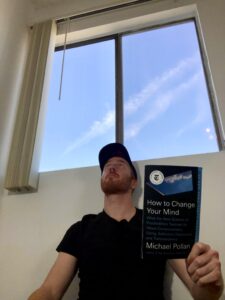 Our society has viewed the use of psychedelic drugs unfavorably for many years. This was not always the case, however, as we are actually in the midst of a second wave of psychedelic research. The first wave came about in the 1950s and 1960s when doctors, psychologists, and university professors were all studying the effects of LSD and psilocybin (the psycho-active drug in magic mushrooms) on their patients. These substances were relatively unknown to the broader public at the time, and yet the researchers who were administering them had high hopes for their application. “A 1967 review article summarizing papers about psychotic therapy published between 1953 and 1965 estimated that the technique’s rate of success ranged from 70 percent in cases of anxiety neurosis, 62 percent for depression, and 42 percent for obsessive-compulsive disorder.” Sadly, however, this research was not to persist; heading into the late 1960s and early 1970s, the public perception of psychedelics changed to one of skepticism and distrust, and these substances were banned by the government. Thus ensued a multi-decade drought of their official study.
Our society has viewed the use of psychedelic drugs unfavorably for many years. This was not always the case, however, as we are actually in the midst of a second wave of psychedelic research. The first wave came about in the 1950s and 1960s when doctors, psychologists, and university professors were all studying the effects of LSD and psilocybin (the psycho-active drug in magic mushrooms) on their patients. These substances were relatively unknown to the broader public at the time, and yet the researchers who were administering them had high hopes for their application. “A 1967 review article summarizing papers about psychotic therapy published between 1953 and 1965 estimated that the technique’s rate of success ranged from 70 percent in cases of anxiety neurosis, 62 percent for depression, and 42 percent for obsessive-compulsive disorder.” Sadly, however, this research was not to persist; heading into the late 1960s and early 1970s, the public perception of psychedelics changed to one of skepticism and distrust, and these substances were banned by the government. Thus ensued a multi-decade drought of their official study.
The past twenty years have seen psychedelic research resurface (it never truly disappeared, but simply went underground) and the preliminary results have been exceptional. Similar to the findings from the first wave, our current second wave of research indicates that psychedelics can be profoundly helpful to people with addiction, anxiety, depression, and obsessive-compulsive behaviors. Patients with these diagnoses report that their mental ‘journeys’ on psychedelics leave them with new found feelings of love and connectedness to a larger ‘whole.’
Our author tries these drugs himself and does his best to put the indescribable into words. The most important theme he illustrates is how psychedelics dissolve the ego, the part of us that sees ourselves as separate from everything else. “LSD truly was an acid,” he writes, “dissolving almost everything with which it came into contact, beginning with the hierarchies of the mind (the superego, ego, and unconscious) and going on from there to society’s various structures of authority and then to lines of every imaginable kind: between patient and therapist, research and recreation, sickness and health, self and other, subject and object, the spiritual and the material.” Basically, LSD washed all the dividing lines away, until everything felt like one and the same. This is difficult to conceptualize without experiencing LSD’s effects firsthand.
Why do psychedelics have this effect on our minds? Researchers suggest that states of mind dominated by addiction, anxiety, depression, and obsessive-compulsive disorders are evidence of rigid thinking, i.e., when the neural grooves of the brain have become set and hardened. The beauty of psychedelics is that they open the mind up to new and different ways of thinking, connecting disparate parts the brain across new neural pathways that allow people to create new habits and change their unhealthy behaviors. Patients who used psychedelics report quitting smoking, for example, because cigarettes were suddenly reframed as something stupid and pointless.
Psychedelic research is a tricky subject to study because it is very dependent on the set and setting of where and how the drugs are administered. “Set is the mind-set or expectation one brings to the experience, and setting is the environment in which it takes place.” Not only do psychedelics affect different people differently, but compared to other drugs, they seldom affect the same person the same way twice. They are also hard to study because it is near impossible to have a control group, a standard practice when using the scientific method.
This is a big reason why this class of drugs has been so hard to get official approval to study—because they are not scientifically rigorous, and are more closely attributed to spiritual practices administered by shamans then clinical studies proposed by doctors. This new wave of psychedelic research is a blend of both, with supreme importance placed on where and how they are administered and in what way the patient is tended to by the psychiatrist. “This is why it is important to understand that ‘psychedelic therapy’ is not simply treatment with a psychedelic drug but rather a form of ‘psychedelic assisted therapy,’ as many of the researchers take pains to emphasize.” It is indeed a hybrid between medical science and shamanic spirituality.
So, this is where we are today: in the midst of a second wave of psychedelic research loaded with promising initial results. While the medical community is skeptical, slow progress is being made, with more converts to the cause with every paper published on the subject. And how about you, dear reader? Do you suffer from addition, anxiety, depression, obsessive-compulsive disorder, or have a mental blockage in your life that you want to move past? Perhaps psychedelics could be exactly what you need to re-wire your brain. After all, this is why our author titled his book How to Change Your Mind.


